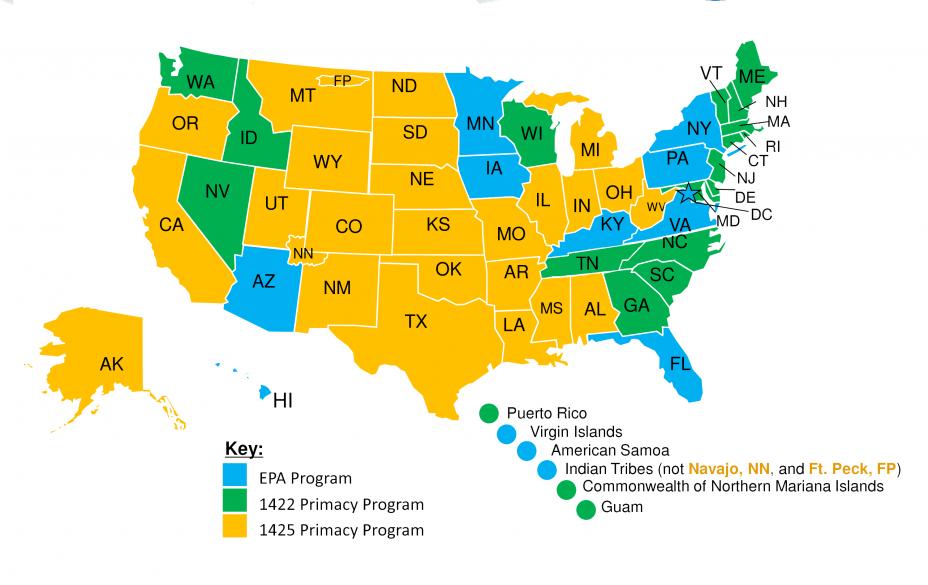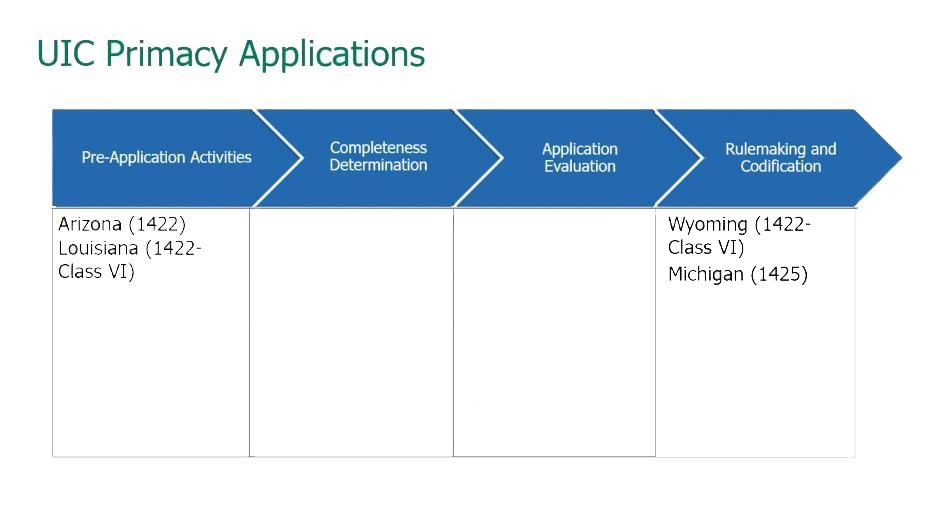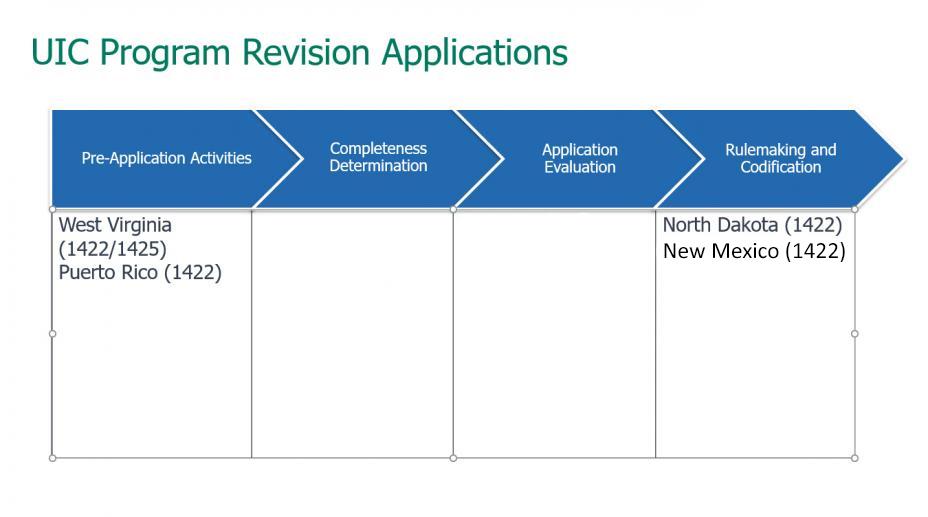Primary Enforcement Authority for the Underground Injection Control Program
On this page:
- What is UIC primary enforcement responsibility (primacy)?
- What states, territories, and tribes have primacy?
- Who implements the program in states, territories, and tribes that do not have primacy?
- What is the process for states, territories, and tribes to apply for primacy or implement a substantial program revision?
- What are the core elements of a primacy application or program revision?
- What states, territories, and tribes are currently in the primacy application or substantial program revision process?
- What states, territories, and tribes have recently completed a primacy application or substantial program revision process?
What is UIC primary enforcement responsibility (primacy)?
Section 1421 of the Safe Drinking Water Act (SDWA) requires EPA to develop UIC program requirements that protect underground sources of drinking water from endangerment. EPA has developed UIC program requirements that are designed to be adopted by states, territories, and tribes.
Primary enforcement authority, often called primacy, refers to state, territory, or tribal responsibilities associated with implementing EPA approved UIC programs. A state, territory, or tribe with UIC primacy, or primary enforcement authority oversees the UIC program in that state, territory, or tribe.
Primacy programs are established under Sections 1422 and 1425 of the SDWA. Section 1422 requires primacy applicants to meet EPA’s minimum requirements for UIC programs. Programs authorized under this section, referred to as 1422 programs, may have primacy for Class I, II, III, IV, V, and VI wells.
Under Section 1422, applicants may submit primacy applications for:
- All well classes
- Classes I – V
- Class VI (only)
Section 1425 requires primacy applicants to demonstrate their standards are effective in preventing endangerment of USDWs. Section 1425 programs are not required to meet EPA’s minimum requirements, provided applicants can show their standards protect USDWs. Section 1425 applies to Class II wells only.
EPA may grant primacy for all or part of the UIC program. This means that in some jurisdictions primacy for certain well classes may be shared with EPA or divided between two different state, territory or tribal authorities.
States seeking UIC program primacy must demonstrate to EPA that the state has: jurisdiction over underground injection; regulations that meet the federal requirements for 1422 programs (or are effective under Section 1425); and the necessary administrative, civil and criminal enforcement penalty remedies.
What states, territories, and tribes have primacy?
EPA has approved UIC primacy programs for well classes I, II, III, IV, and V in 32 states and three territories. Two states have primacy for well classes I, III, IV, and V and two states have primacy for Class VI. Additionally, there are seven states and two tribes that have primacy for Class II wells only.
North Dakota and Wyoming are the only states with primary enforcement authority for UIC Class VI wells. EPA directly implements the Class VI program in all other states, territories, and tribes.

EPA directly implements the Class II program in nine states, three territories, the District of Columbia, and for all tribes except for the Navajo Nation and Fort Peck Tribes. Twenty five states and two tribes have UIC Class II primacy under SDWA Section 1425. Sixteen states and three territories have UIC Class II primacy under SDWA Section 1422.

Who implements the program in states, territories, and tribes that do not have primacy?
If a state, territory, or tribe does not obtain primacy for all or some UIC well classes, EPA implements the program directly through one of its regional offices. Currently, EPA implements the UIC program for all well classes in nine states and two territories. Apart from the Navajo Nation and Fort Peck Class II programs, EPA directly implements the UIC program in Indian country.
View a summary of state, territory, and tribal responsibilities for the UIC program.
What is the process for states, territories and tribes to apply for primacy or implement a program revision?
The UIC primacy application process is presented at 40 CFR part 145 and includes requirements for states, territories and tribes applying for UIC program primacy. Additionally, EPA guidance documents describe the general procedures for the Agency's review and approval of primacy and program revision applications. These documents include:
- Guidance for Review and Approval of State Underground Injection Control Programs and Revisions to Approved State Programs - Ground Water Program Guidance #34 (Guidance 34) provides guidance to EPA regional offices on the process for the approval of state primacy application and the process for approving program revisions for programs approved under both 1422 and 1425.
- Guidance for State Submissions Under Section 1425 of the Safe Drinking Water Act (SDWA) - Ground Water Program Guidance #19 (Guidance 19) provides guidance on: how states may apply for primacy approval under Section 1425 of the SDWA and the criteria EPA will use in approving or disapproving an application (applies only to Section 1425 applications).
Consistent with these guidance documents and governing EPA regulations, EPA’s UIC Program developed operating procedures to streamline the review and approval process and to facilitate transparency and consistency in primacy and program revision evaluations and approvals. These procedures divide EPA’s responsibilities and interactions with states, territories and tribes into four general phases.
- Phase I: pre-application activities
- Phase II: completeness review and determination
- Phase III: application evaluation
- Phase IV: rulemaking and codification
Phase I: pre application activities
This phase begins when EPA engages with a state interested in applying for UIC program primacy or implementing a program revision. During this phase, EPA may support a state in identifying available resources and the critical elements (i.e., the governor’s letter, attorney general’s letter, program description, memorandum of agreement, and public participation documentation) of a primacy application or program revision. EPA may also meet with the state to outline the process, address preliminary questions a state, territory or tribe might have, and determine the scope of a state’s actions (e.g., all well classes, Class II only, or Class I – V, or Class VI only).
Additionally, EPA may work with the state to review the state’s draft UIC statutes and regulations and encourage a state to complete a comparison crosswalk. The crosswalk provides a method to efficiently compare the federal regulations with the state's draft statutes and regulations.
Download the SDWA 1422 checklist and SDWA 1425 crosswalk template.
Phase II: completeness review and determination
During the Completeness Review and Determination Phase, EPA receives and reviews complete drafts of applicable critical elements of a state submission including the governor’s letter, attorney general’s letter, program description, memorandum of agreement, and public participation documentation. The EPA and a state may engage in a continued dialogue to ensure that questions are clarified prior to the end of this phase. It is also possible that a state, territory or tribe may identify regulatory or statutory changes that must be implemented prior to completion of this phase.
Phase III: application evaluation
The Application Evaluation Phase encompasses a comprehensive evaluation of the regulations and other elements of the primacy application or program revision package. During this phase, EPA will evaluate, in detail, every aspect of each element and coordinate with an applicant to gain clarity and confirm stringency or effectiveness.
During this phase, EPA publishes a proposed rule signed by the EPA Administrator which indicates EPA’s intent to approve or disapprove of a primacy application or program revision. The public is given at least 30 days to comment on the state’s UIC primacy application during which time the public may request a hearing. When a public hearing is requested, EPA arranges the date, time and location of the hearing, and notifies the public.
At the close of the public comment period, EPA reviews public comments received during the public hearing as well as written comments submitted to the EPA Docket. Depending on the comments, EPA may re-review the state’s primacy application and request changes.
Phase IV: rulemaking and codification
During Phase IV, EPA drafts the final rule approving, or disapproving, the state’s primacy application or program revision. The final rule package includes: a summary of the public comments and EPA’s responses; documentation of any changes from the state’s original application and EPA’s rationale for finalizing the rule with such changes; and the regulatory text that will be codified in 40 CFR part 147 after the program is approved.
The final rule is signed by the EPA Administrator and published in the Federal Register with the date of publication as the rule’s effective date.
What are the core elements of a primacy application or program revision?
UIC Program regulations at 40 CFR part 145 identify six core elements of a UIC primacy application or substantial program revision. Each of the six requirements are identified below. For a new primacy application all documents are required. For program revisions, depending on the nature of a state’s UIC program changes, a state may need to revise one or more of the six core elements and submit a revised primacy application to EPA.
Governor's letter
This core element is a signed letter from the governor of the state requesting approval for UIC program primacy. The governor's letter must specify that approval is sought under sections 1422 or 1425 of the SDWA.
Review examples from recently approved programs.
Program description
This core element is a document describing in narrative form the scope, structure, coverage and processes of the state program.
Review examples from recently approved programs.
Attorney general's statement
The Attorney General's statement is a certification by a qualified representative of the state, asserting that the state’s statutes, regulations and judicial decisions demonstrate adequate authority to administer the UIC program.
Review examples from recently approved programs.
Memorandum of agreement between the state and the EPA regional administrator
The memorandum of agreement (MOA) is the central agreement setting out the provisions and arrangements between the state and EPA. The MOA describes the administration, implementation and enforcement of the state’s UIC program.
Review examples from recently approved programs.
Copy of the state's UIC statutes and regulations
States seeking primacy under Section 1422 may incorporate the federal regulations by reference, adopt the federal language verbatim, or draft provisions that are as stringent as the federal requirements.
States seeking primacy under Section 1425 must demonstrate that their Class II regulations are effective in preventing underground injection that endangers USDWs.
Documents demonstrating the state's public participation process
The state must provide documentation of the public participation process the state used to notify the public of its intent to apply for primacy.
What states, territories, and tribes are currently in the primacy application or program revision process?
Status of state, territory, and tribal primacy and program revision applications
 Status of state, tribal, or territory UIC primacy applications with applicable references to the Safe
Status of state, tribal, or territory UIC primacy applications with applicable references to the Safe
Drinking Water Act.
Michigan
The EPA is taking direct final action to approve the State of Michigan’s UIC program for primacy. EPA has determined that the state’s program is consistent with the provisions of the SDWA at section 1425 to prevent underground injection activities that endanger underground sources of drinking water. EPA’s approval allows Michigan to implement and enforce its state regulations for UIC Class II injection wells located within the state. Michigan’s authority excludes the regulation of injection well Classes I, III, IV, V, and VI, and all wells in Indian country, as required by rule under the SDWA.
Review the Federal Register Notice documenting the Agency's action.
Wyoming
The EPA recently approved an application from the State of Wyoming under the SDWA to implement the UIC program for Class VI injection wells to protect USDWs within the state, except within Indian lands. EPA will continue to administer all well classes within Indian lands. Class VI wells are used for the underground injection of carbon dioxide into deep subsurface rock formations for long-term storage.
Review the Federal Register Notice documenting the Agency's action.
New Mexico
The EPA proposes to approve an application from the State of New Mexico under the SDWA to revise the State’s existing UIC program for Class I hazardous waste injection wells located within the State, except those in Indian country. The State of New Mexico is revising its UIC Class I program regulations to establish new permit conditions, oversight, and enforcement to safely manage Class I hazardous waste disposal wells.
Review the Federal Register Notice documenting the Agency's action.
